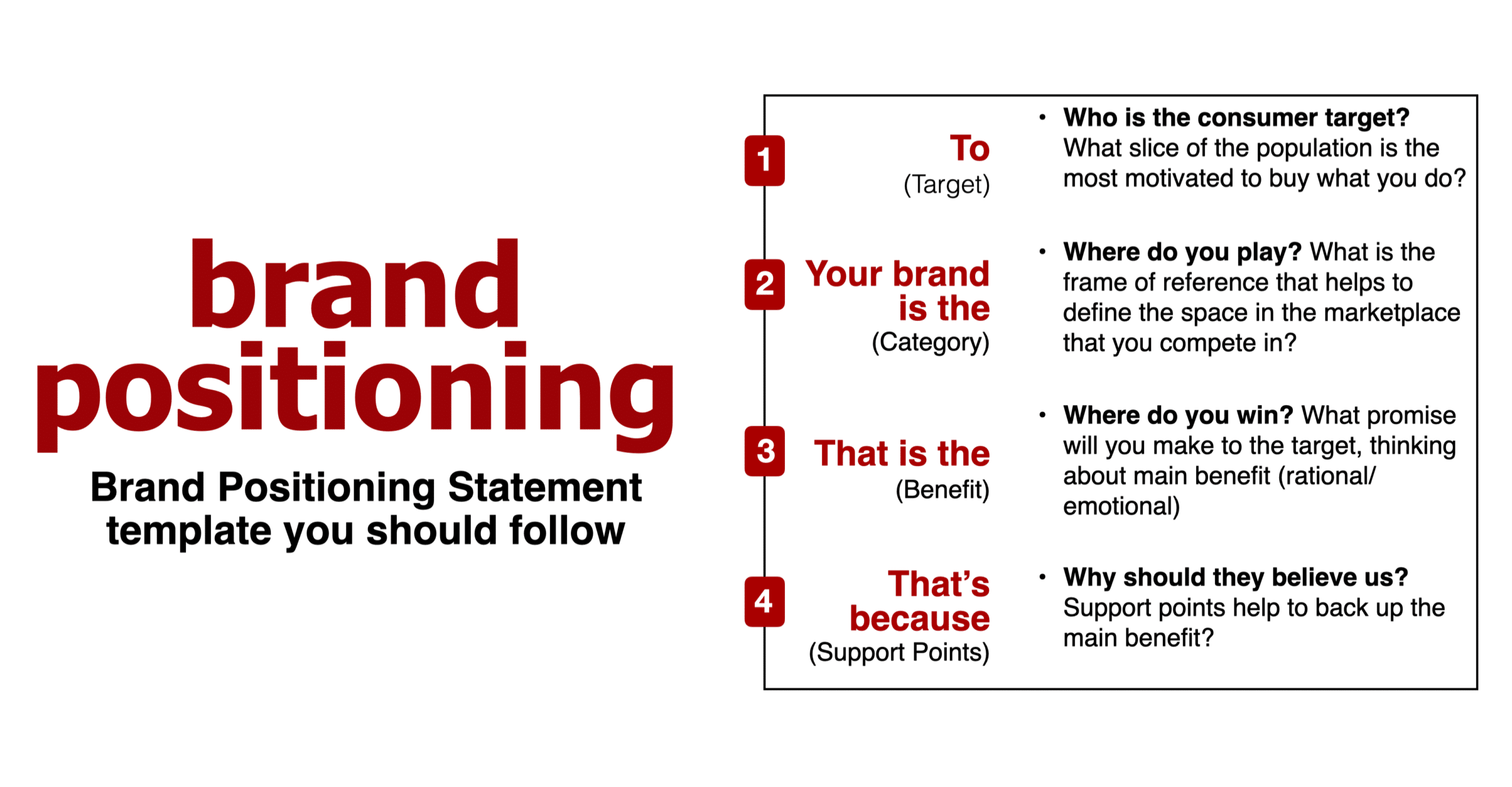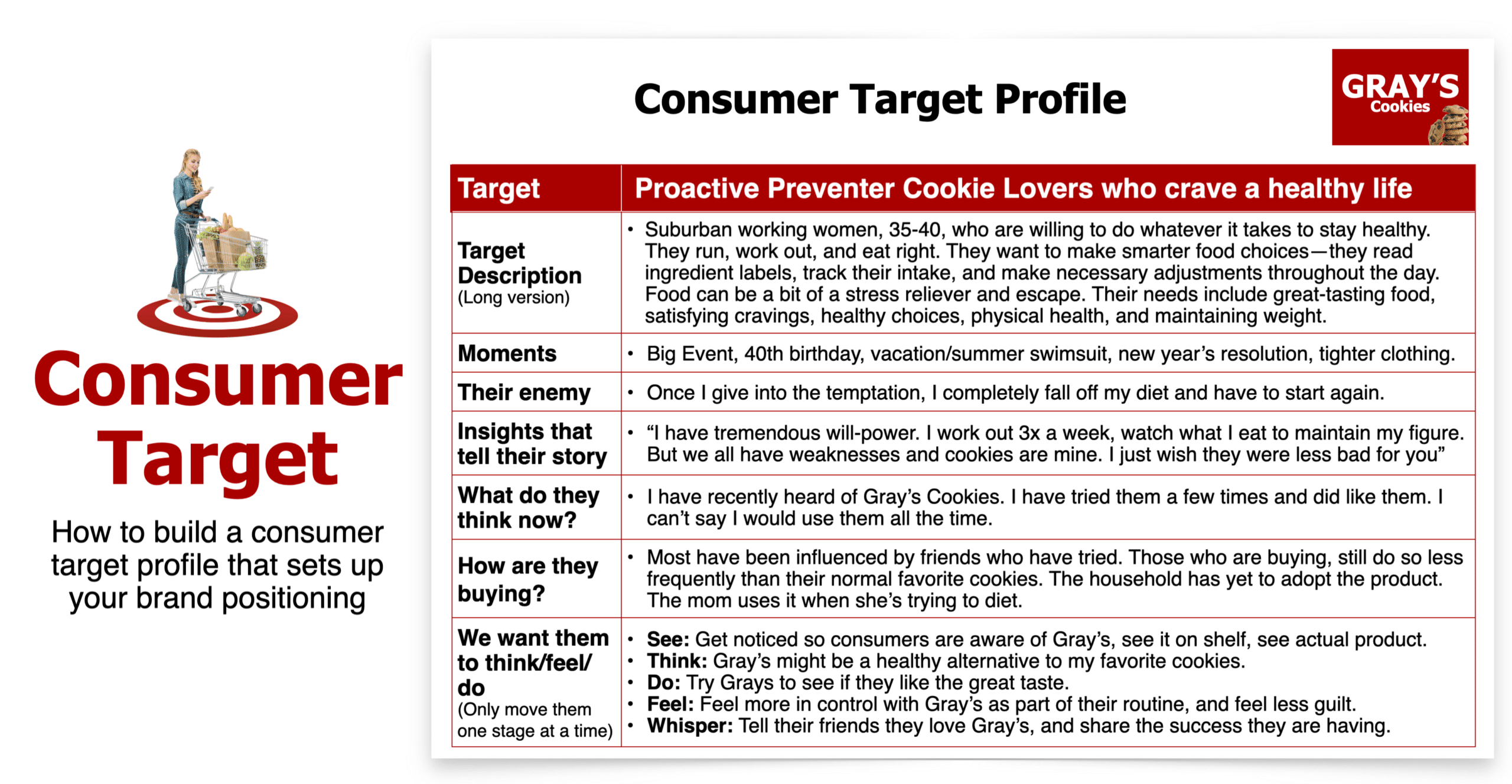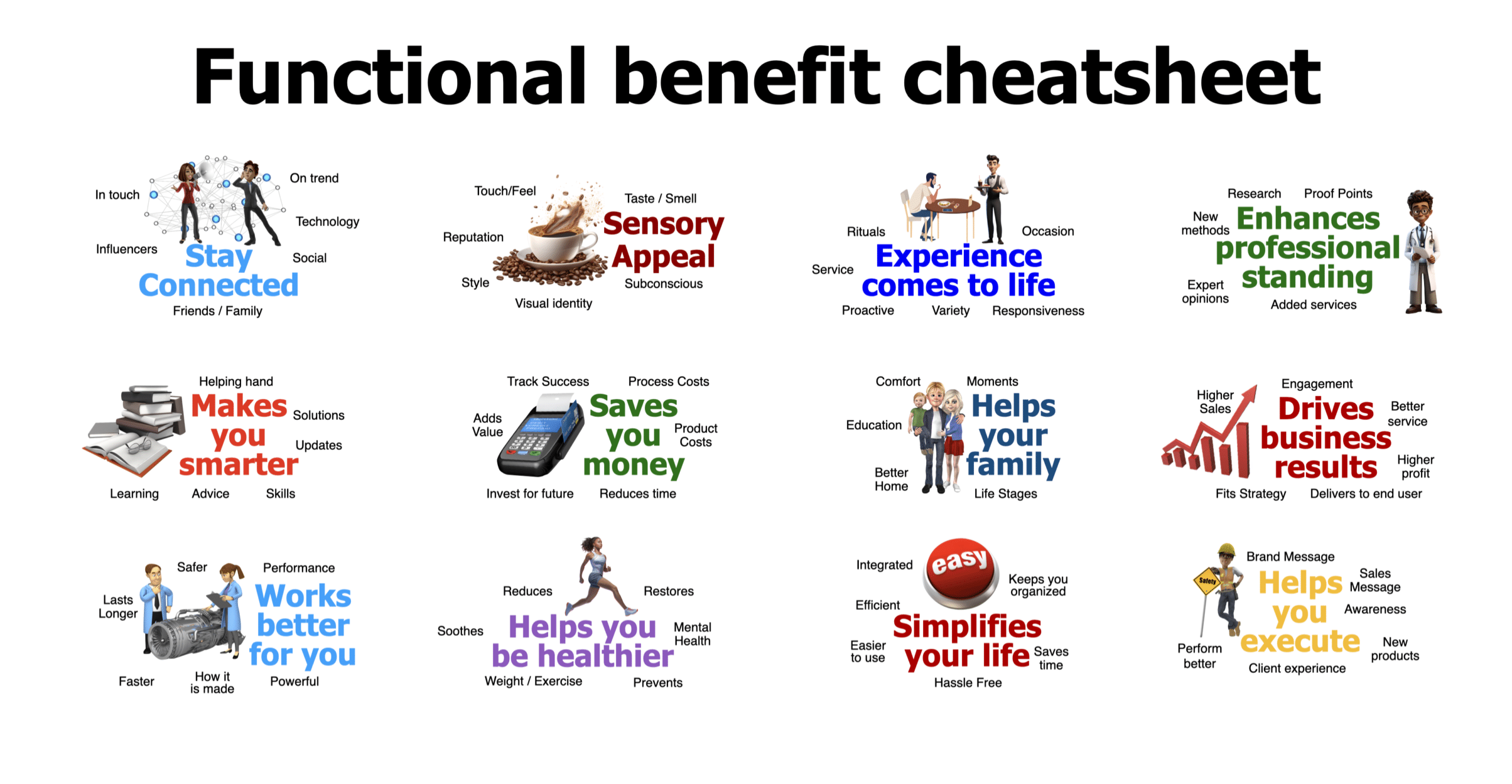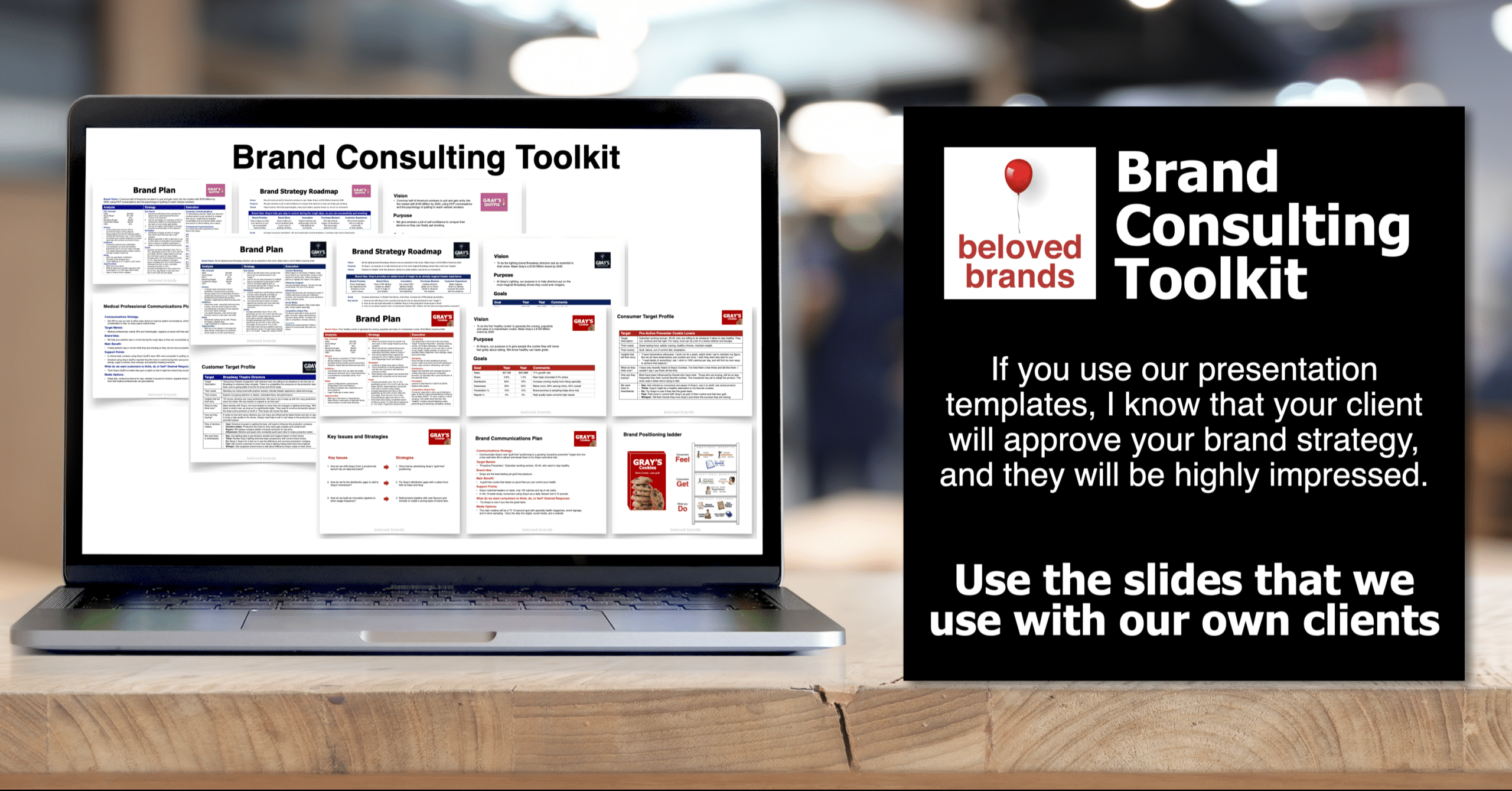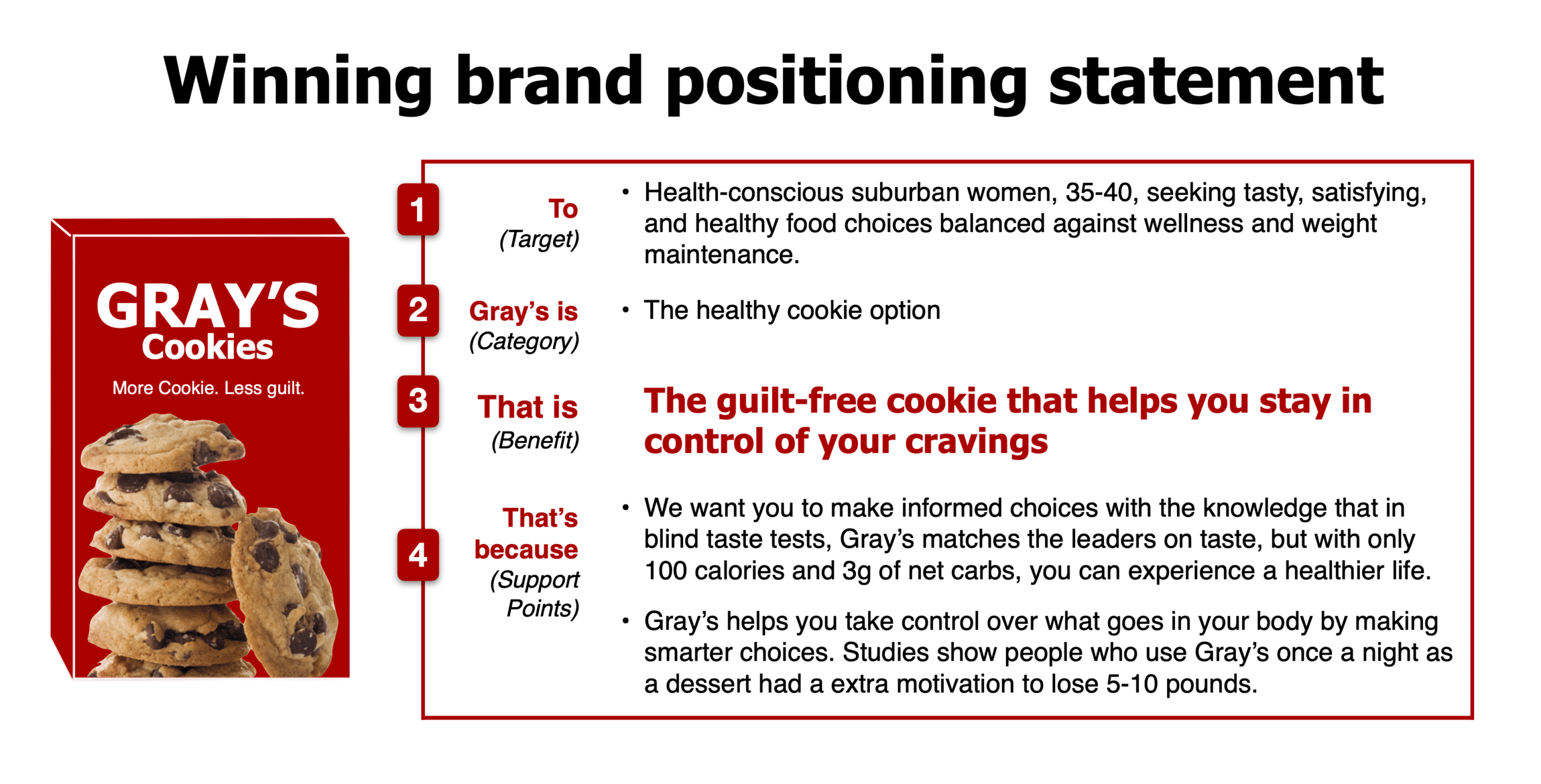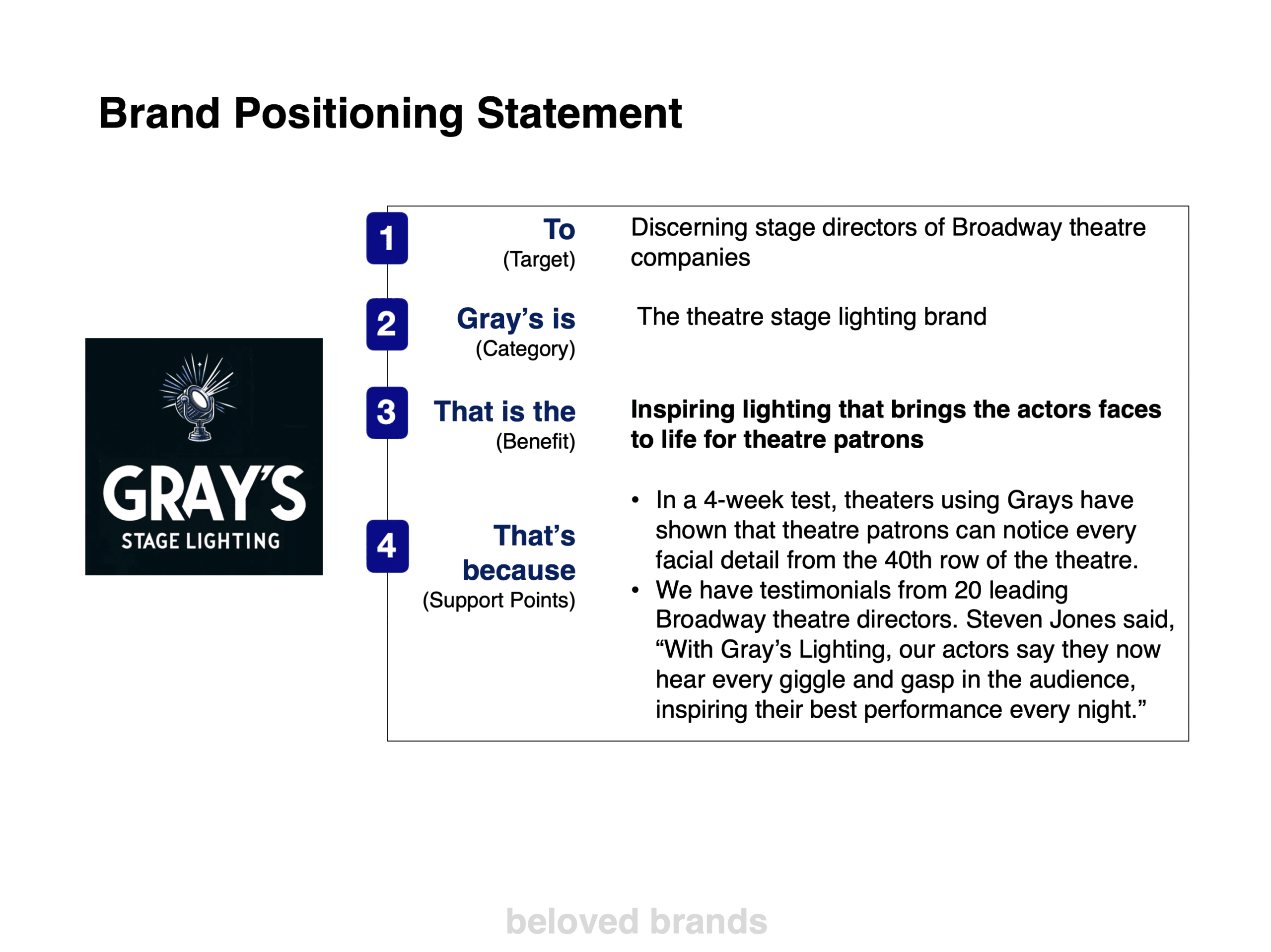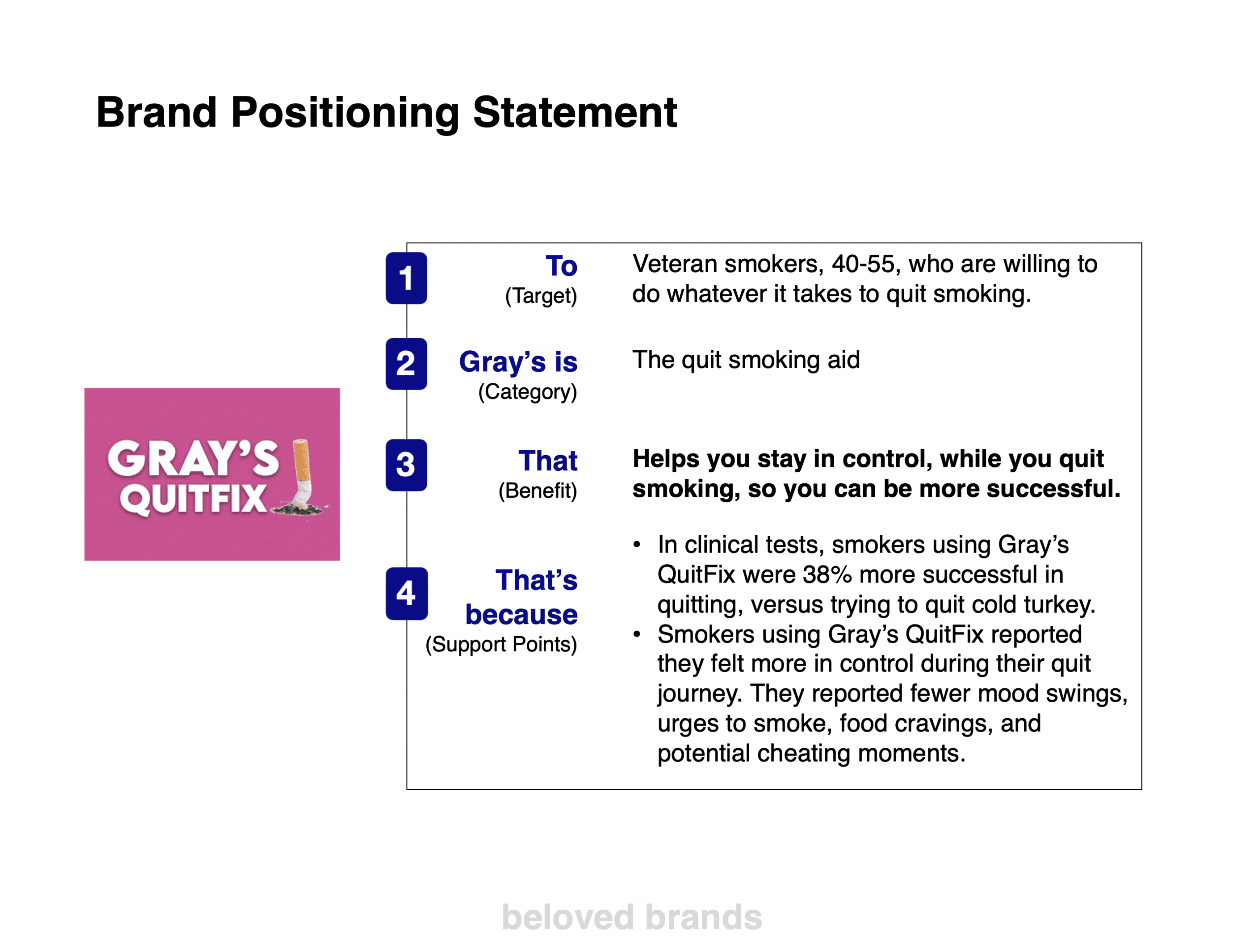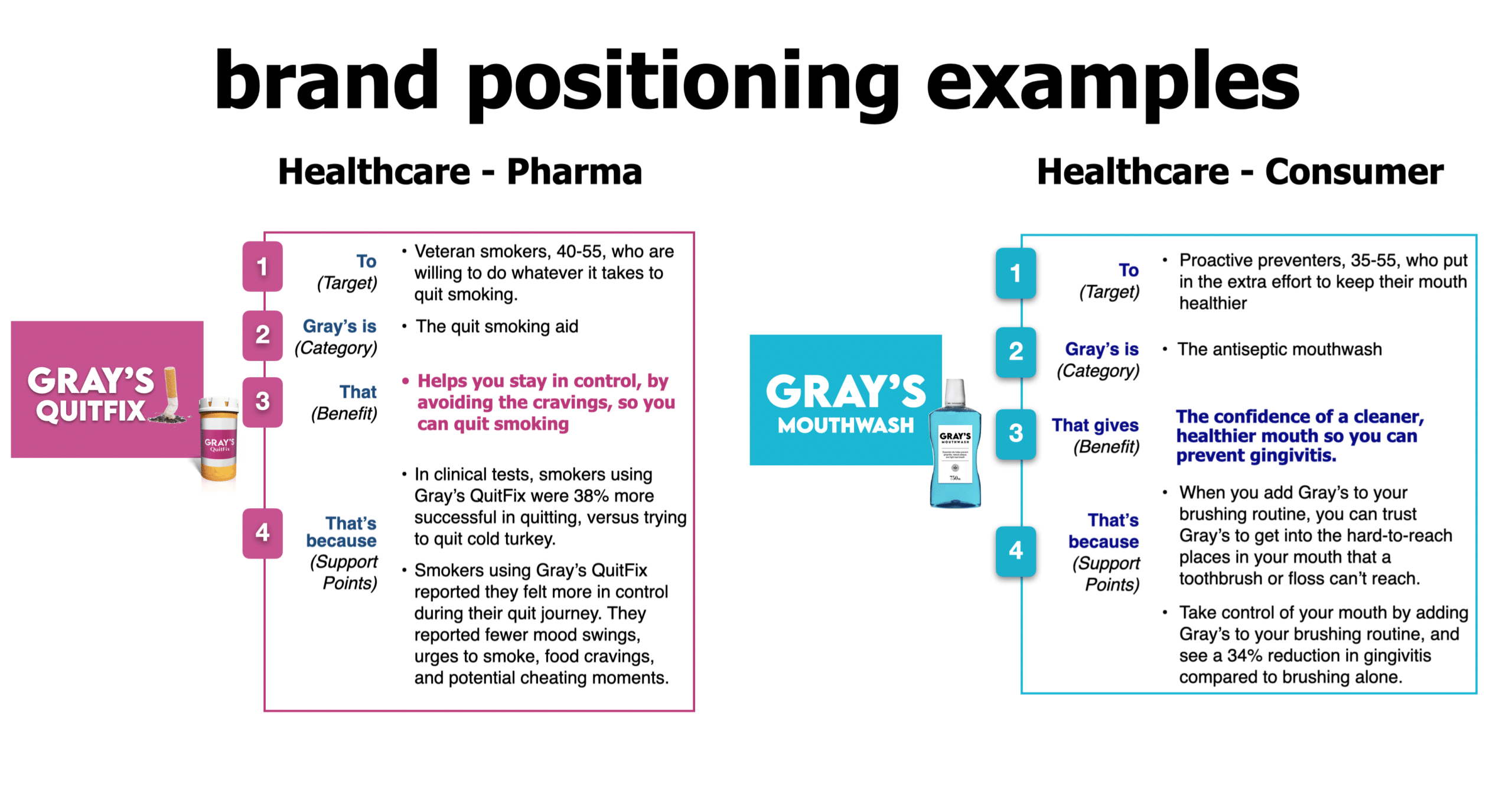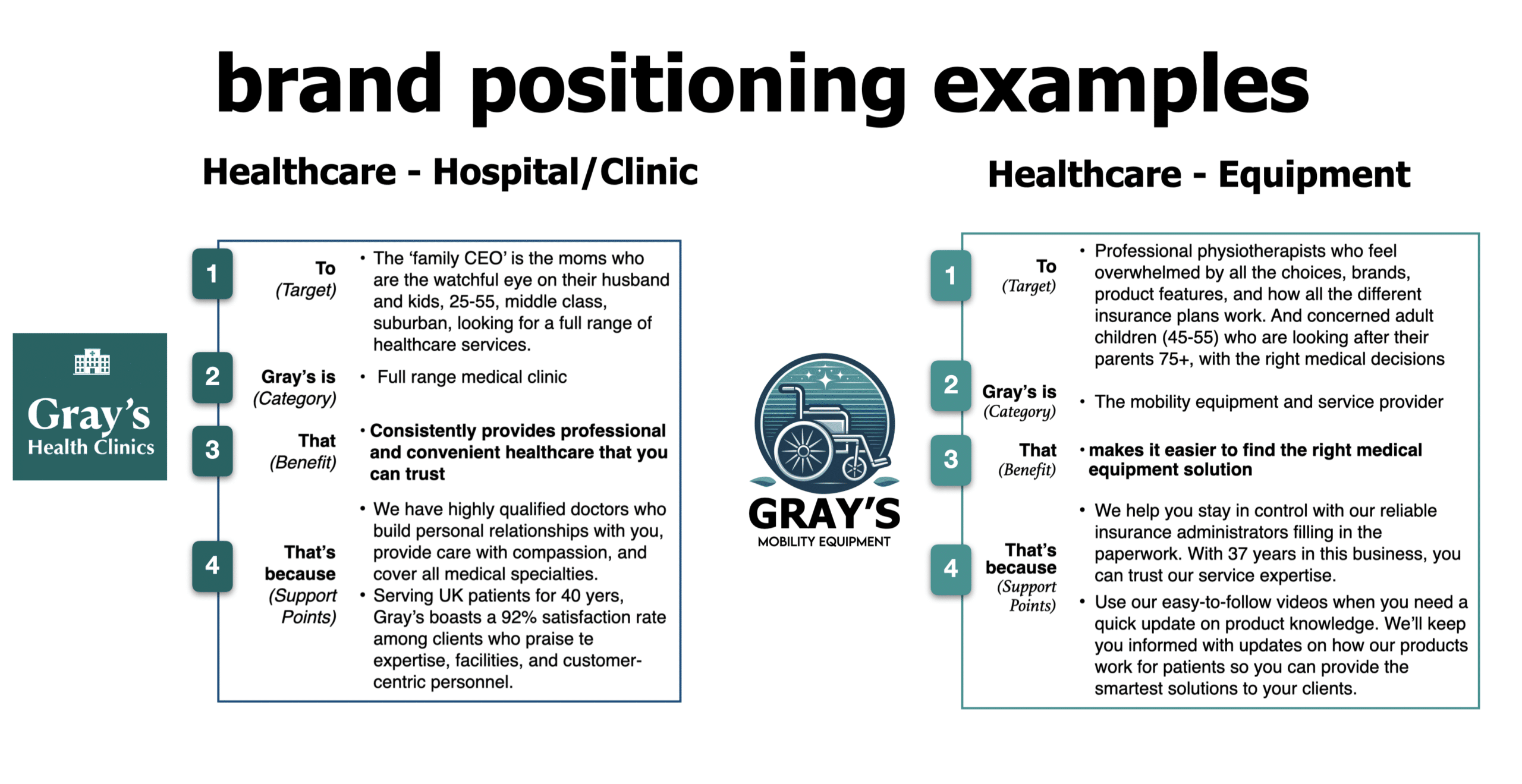If you are working on Brand Positioning for your brand, then you are in the right spot. What is a brand positioning strategy? A Brand Positioning Statement defines how your brand shows up in the market. Importantly, it should outline your ideal target consumer, the space you play in, your main message that differentiates your brand from others, and the support points. Too many brands are negligent in differentiating themselves from competitors and end up stuck in the clutter of the market. Our brand positioning process provides a logical approach to getting more emotional. We have cheat sheets to find the ideal functional and emotional benefits. To illustrate, you will find 20 different examples of brand positioning statements within this article.
Can you describe your brand in a way that motivates consumers to engage with your brand in a space that is ownable for your brand?
Essentially, we have brand positioning statement examples for a type of brand close to yours. We include examples of consumer packaged goods retail, restaurants, tourism, B2B, cars, beer and alcohol, healthcare and pharma, and many famous brands.
Brand Positioning - Identify where can your brand win
To find your ideal brand positioning statement, you want to find the most motivating space for consumers. And find the space that is most ownable for your brand. Our brand positioning statement process starts with a defined consumer target your brand will serve. Then, we focus on the emotional and functional benefits that differentiate your brand. Further, we use support points to help differentiate your brand from competitors.
Brand positioning is the conceptual space a brand owns in the consumer’s mind. It’s what they think of you. Importantly, as you dig in on creating your brand positioning statement, look for the space to play, and then the ideal space can differentiate your brand to win in the market.
Brand Positioning is all about how to differentiate.
To start, the first circle comprises everything your consumer wants or needs. Next, the second circle includes everything your brand does best. Finally, the third circle lists what your competitor does best.
Your brand’s winning zone (in green) is the space that matches up “what consumers want” with “what your brand does best.” Most importantly, you can own and defend this space from attack. Essentially, you can satisfy the consumer’s needs better than any competitor.
Your brand will not survive in the losing zone. (in red) This space matches the consumer needs with “what your competitor does best.” Consequently, you will fail to differentiate, and your competitor will beat you every time.
What happens when there is a tie?
As markets mature, competitors copy each other. It gets harder to be better with a definitive product win. Many brands play in this risky zone (in grey). If you and your competitor meet the consumer’s needs in a relative tie, you can win the tie with emotions and innovation.
You will fail if you only focus on using product features to differentiate your brand. As the market matures, competitors copy each other. And that winning green space gets very small. Instead, you can carve out a winning brand positioning space by focusing on the emotional benefits. In this article, I will show you our logical way to engage with our Emotional Cheat Sheet, which has 40 emotional benefits to play with.
Avoid the dumb zone
Sadly, I always have to mention the dumb zone. (in blue) Here, two competitors “battle it out” in a space where consumers do not care. One competitor says, “We are faster,” and the other brand says, “We are just as fast.” However, no one bothered to ask the consumer if they cared about speed. Both brands end up failing to differentiate and playing in the dumb zone.
Table of Contents - How to write a Brand Positioning Statement
Brand Positioning Maps
Before you get started on the details of your positioning statement, you can sketch out where brands currently play. A brand positioning map allows you to see the most cluttered space and the open space. The brand positioning map provides some direction on establishing a unique positioning for your brand. But it doesn’t provide much detail. Significantly, our process will help narrow the specifics of your brand positioning statement.
Pick two dimensions that matter to consumers.
Below, we can assess the market for sit-down chain restaurants in the US. First, we look at price; high versus low. Then, we might add in flavors; traditional American vs. International. To illustrate, we see two gaps in the market; high-end International and upper-mid American. Moreover, we see a cluttered mess in lower-end American restaurants.
Drawing from my experience with Brand Positioning
As a former VP of Marketing, I have seen the impact a smart brand positioning can have on a brand. Equally, I have also seen poor brand positioning work based on random guesses rather than a smart process. Brand Positioning impacts your brand communications, future product innovation, the purchase moment, and the customer experience.
While I spent 20 years in marketing and loved every day, my current role is to teach marketers the essential marketing skills to help them in their marketing careers. Brand Positioning is one of the core elements of our Marketing Training.
Brand Positioning Video
Our Marketing in about 60 seconds video goes through the best-in-class process to use functional and emotional consumer benefits to build your brand positioning. Our video gives you a good overview and any details you can find in the rest of this post.
The four key elements of a Brand Positioning Statement
Four elements make up a brand positioning statement. To start, define who you will serve (consumer target). Then, define where you will play (category) and where you will win (main benefit statement). To back up your main benefit, use support points to explain why consumers should believe you (reason to believe).
1️⃣ Who is the consumer target?
First, define a slice of the population most motivated by what your brand offers. However, don’t just think about who you want but who wants your brand.
2️⃣ Where will you play?
Next, consider the competitive set that defines the space in the market your brand competes in. Brand positioning is always relative to who you compete against. For instance, a brand is never fast. It should be faster.
3️⃣ Where will you win?
What is the central promise you will make to the consumer target? It should differentiate your brand to be interesting, simple, unique, motivating, and ownable. Do not talk about what you do. (Features) Instead, talk about what the consumer gets (functional benefits). And talk about how the brand makes them feel. (emotional benefits)
4️⃣ Why should they believe us?
Finally, lay out the support points and features needed to back up the main promise. Moreover, these support points should close any potential doubts, questions, or concerns the consumer has after hearing the main promise.
Our Brand Positioning Template is available in a PowerPoint presentation
Introducing our brand positioning for consumer brands template that includes everything you need to effectively communicate your target profile, brand positioning statement, brand idea, brand concept, brand values, brand story, brand credo, and creative brief. Moreover, these slides can serve as the strategic elements of your brand book.
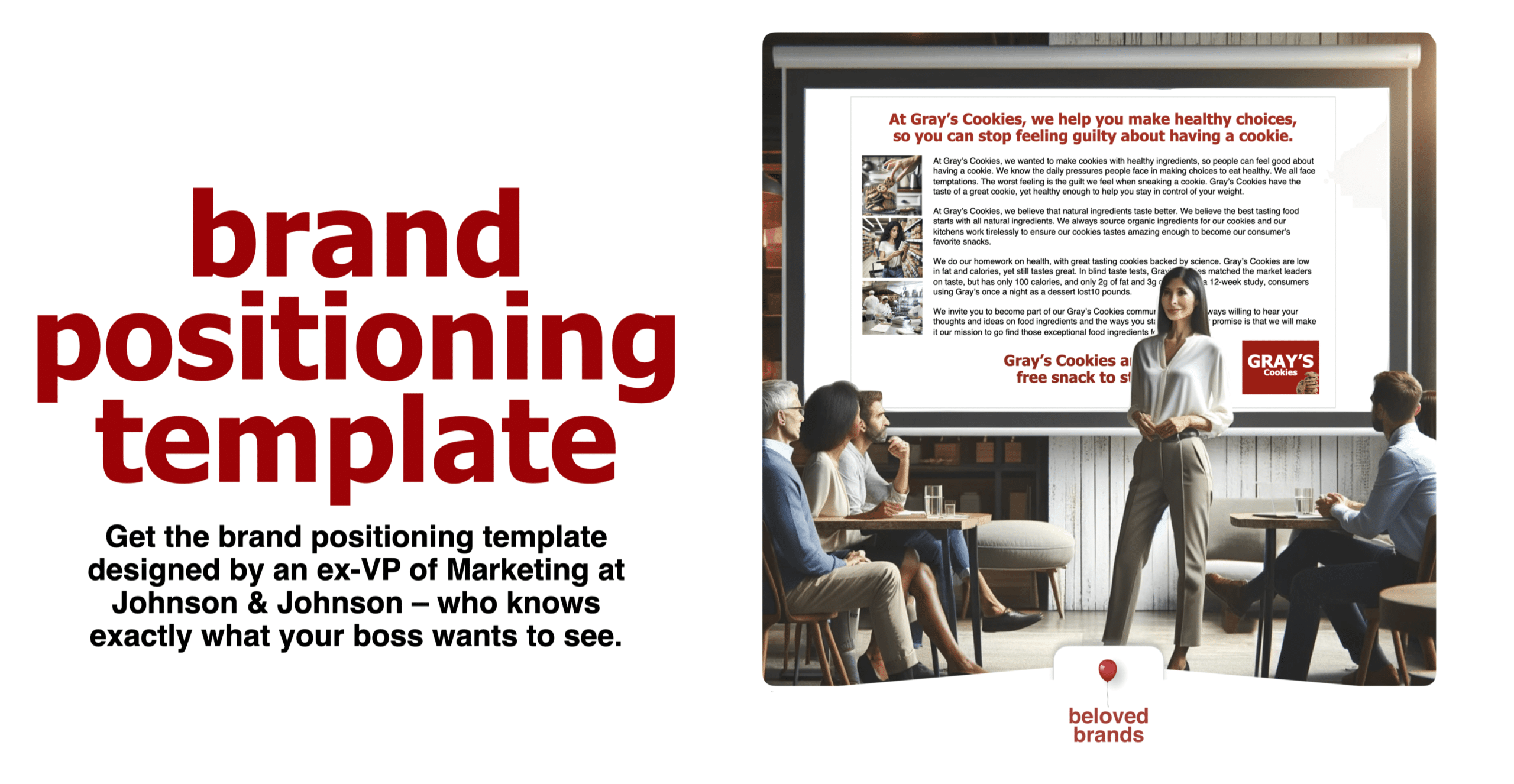
Brand Positioning Process
If you do not define your brand, then you risk the possibility that your competitors will define your brand. And you might not like it.
In this post, I will show you the homework you must do to create a winning brand positioning statement. The tools are designed to help you decide who your brand will serve and what it stands for. You will learn to find the ideal balance between the functional and emotional benefits to find which ones are simple, interesting, motivating, and ownable for your brand.
Identifying the Consumer target
Focus on those who are the most motivated by what you do. There is this myth that a bigger consumer target will make the brand more significant, so scared marketers target ‘everyone.’ For instance, there seems to be an irrational fear of leaving someone out.
Moreover, a broad consumer target gives your brand a lower return on investment and eventually will drain your brand’s limited resources. Please focus. Below, you will find a consumer profile that sets up Gray’s Cookies as an example of our brand positioning. We include consumer insights to give flavor to the target.
Building a Target Profile
Identifying gaps in the marketplace
To identify where you have an opportunity, you can use market research to help plot your competitors. Plot each brand based on the functional and emotional benefits, and you will begin to see space where there may be an opportunity for you to win. Below, you can see how Gray’s Cookies and Oreo match up regarding functional and emotional benefits. The farther from the center, the stronger that brand plays on that element. Oreo wins on sensory appeal, experience, comfort, and feel-good. To illustrate, you can see Gray’s has the opportunity to win on healthier, smarter, and stay in control.
To illustrate, click on our Brand Positioning spider map to differentiate from your competitor.
Using the Consumer Benefits Ladder
Turn your brand’s features into consumer benefits. Stop thinking about what your brand does. And, start thinking about what your consumer gets. As a result, your brand positioning statement comes alive.
The four steps to build a Consumer Benefits Ladder
First, leverage all available consumer research to brief the team. Above all, define the consumer target profile with consumer insights, need states, and the consumer enemy.
Second, brainstorm all possible brand features your brand offers and any brand assets. Importantly, focus on the features that give your brand a competitive advantage.
Next, move up to the functional benefits. Put yourself in the consumer’s shoes, and for each feature on your list, ask, “If I am the consumer, what do I get from that?” Keep asking with answers that differentiate and move into a richer zone.
Finally, move up to the emotional benefits by looking at each functional benefit and asking, “So, if I am the consumer, how does that make me feel?” Clearly, keep asking the question until you see a deeper emotional space that you can play in that will help differentiate your brand.
Avoid using lazy words in your brand positioning
Avoid vague words that mean so many things, they mean nothing at all. For example, ambiguous words include nice, great, interesting, or quality.

When you define your brand positioning, the specific words you choose must matter to your consumers. Importantly, your brand positioning statement should leave zero room for interpretation.
This type of thinking is part of our Beloved Brands positioning process. To help, keep reading below to see how we provide two consumer benefit cheat sheets with 60 functional benefits and 40 emotional benefits to help you write with much more specific words that differentiate your brand.
Functional Consumer Benefits Cheatsheet
Our functional benefit cheatsheet determines where you can win
To help brand leaders, I have taken twelve functional benefit zones and expanded the list to over 50 potential functional benefits your brand can build around. Our functional benefits zones include helping consumers stay connected, making them smarter, saving money, simplifying life, helping them be healthier, helping their family, providing sensory appeal, helping their experience come to life, working better, enhancing their professional standing, driving business results, and helping execute.
As you look through the list, gravitate to 2-3 of the functional benefit zones you think will fit the needs of your consumers and where your brand can do it better than competitors. Start with the words on the cheatsheet below, then layer in your creative language based on specific category words or specific consumer words and phrases they use.
What is a brand positioning strategy? Click on our Functional Benefit Cheatsheet to see how to differentiate.
Emotional Consumer Benefits Cheatsheet
Our emotional benefit cheatsheet determines where you can win
From my experience, marketers are better at finding the ideal rational benefits compared with how they work at finding the ideal emotional benefits for their brands. As a brand, you want to own one emotional space in the consumer’s heart as much as you own a rational space in the consumer’s mind.
When I push brand managers to get emotional, they struggle and opt for what they view as obvious emotions, even if they do not fit with their brand. I swear every brand manager thinks their brand should be the trusted, reliable, and likable. Use our cheat sheet to dig deeper on emotions.
Our emotional cheatsheet has twelve emotional consumer benefit zones, which include knowledge, control, comfort, self-assured, optimism, feel myself, liked, freedom, get noticed, sense of belonging, revitalized, and pride.
What is a brand positioning strategy? Click on our Emotional Benefit Cheatsheet to see how to differentiate.
Gray's Cookies benefit clusters
To start, look at the two cheat sheets and narrow them down to potential clusters of functional and emotional benefits. Ideally, match what consumers want and what your brand does best. Then, take three zones from each cheat sheet and add 2-3 support words per zone to create a cluster. For example, below are key benefit words we will use to set up Gray’s Cookies as one of our examples of brand positioning statements.
To illustrate, click on our Consumer Benefit sort above. What is a brand positioning strategy?
Consumer benefit cluster
Once you focus on the main benefits, you will see a cluster of benefits for your brand. I call this the brand thesaurus. Use these choices to build out a brand positioning statement. Also, you can hand this cluster to your execution team and tell them to stick to these words as they build out their day-to-day communication. To illustrate, below is a completed example of the benefit ladder for Gray’s Cookies.
What is a brand positioning strategy? To illustrate, click on our Consumer Benefit Ladder above.
Turn benefit clusters into benefit statements to differentiate your brand
Next, for each cluster, use the words to inspire a brainstorm of specific benefit statements that fit your brand, using the specific brand, consumer, or category words. For example, we’ll use Gray’s Cookies, a fictional cookie brand that combines great taste and low calories. Concerning functional benefits, I have chosen to build around functional clusters, such as healthy, sensory, and experiences, and emotional clusters, such as control, knowledge, and optimism.
What is a brand positioning strategy? To illustrate, click on our Consumer Benefits brainstorm above.
Find the winning space that differentiates your brand in the market
To illustrate, I have created a 2×2 grid to help sort through the potential benefits to find the winners, according to which are most motivating to consumers and most ownable for your brand.
What is a brand positioning strategy? To illustrate, click on our Brand Positioning test above.
The same four zones from the Venn diagram are now on the consumer benefits sort grid, including the winning, losing, risky, and dumb zone.
First, the “guilt-free” consumer benefit is highly motivating and highly ownable for the brand, landing in the winning zone. This space best differentiates your brand from others in the market.
On the other hand, the consumer benefit of a “new favorite cookie” is highly motivating but already owned by the central power players, so it falls into the losing zone. Then, the “feel more confident” benefit falls into the risky zone. Finally, the benefit of “more comfort in choices” is neither motivating nor ownable, so it falls into the dumb zone.
Reasons to Believe Support Points
I took one logic class at University, and the only thing I learned was ‘premise-premise conclusion.’ Easy class, but the lesson has stuck with me:
- First, all fish live in water (premise)
- Next, tuna are fish (premise)
- Therefore, tuna live in the water (conclusion)
In a brand positioning statement, the main consumer benefit is the conclusion, with a need for two support points as the premises. Therefore, the reason to believe (RTB) should never be the conclusion. If pure logic teaches us that two premises are enough to draw any conclusion, then you only need two RTBs.
Brands that build concepts with a laundry list of RTBs are not doing their job in making focused decisions on what support points are needed. With consumers seeing 5,000 advertising messages daily, having a long list of support points risks cluttering their brand communications. Claims can be an effective tool in helping to support your reason to believe and to help differentiate a brand.
There are four types of claims you can use on your brand:
Process Support
- First, look at how your product works differently.
- Then, showcase what you do differently within the production process.
- Finally, what added service/details do you provide in the value chain?
Product Claims
- First, what is the usage of an ingredient that makes you better?
- Then, look at the process or ingredient that makes you safer.
Third-person endorsement
- To clarify, who are the experts in the field who can speak on your behalf?
- To sum up, look to past users/clients with the proof support of their stories.
Behavioral Results
- To help, look at clinical test results.
- Most importantly, assess the in-market usage study.
- Finally, look at before and after studies.
The reason to believe
As you narrow in on the main benefit, look at it from the consumer’s vantage and see if there are gaps you need to fill in with support statements. Use four types of claims, whether linked to what you do differently in the process, how your product works better, third-person endorsements, or behavioral results.
For process support, you can explain how your product works differently, showcase what you do differently within the production process, or discuss any added service you provide in the value chain.
To use product claims, highlight the usage of an ingredient that makes your brand better, different, safer, or cheaper.
Use third-person endorsements when you can access experts who can speak on your brand’s behalf or a substantial collection of past users/clients who can demonstrate proof of performance based on stories or reviews. And explore recognized awards, such as J.D. Power or whatever is recognized in your industry. Definitely, reach for behavioral results when you have a clinical test, in-market usage study, or before and after studies.
What is a brand positioning strategy? To illustrate, click on our Brand Positioning support points to differentiate.
Using the brand thesaurus to improve your writing
Once you have selected your functional and emotional clusters, you can create a brand thesaurus of keywords that define the brand. Using our Gray’s Cookies brand example, we can see the difference between the support points we came up with and then rewritten to layer the keywords into the phrase. Hand this brand thesaurus to everyone who works on the brand to keep everyone aligned with the brand positioning. You will see smarter social media posts, in-store signage, and customer presentations.
What is a brand positioning strategy? To illustrate, click on our Brand Positioning support points to differentiate.
Final Brand Positioning Statement
In conclusion, here is our Gray’s Cookies case study, which serves as one of our examples of brand positioning statements. The guilt-free uses emotions to help differentiate the brand from other cookies.
To illustrate, click on our Brand Positioning example above. What is a brand positioning strategy?
Brand positioning for B2B brands
As you did with Gray’s Cookies, start by looking at the two cheat sheets and narrow down to potential clusters of the B2B functional and B2B emotional benefits. Most importantly, match what customers want and what your brand does best. I recommend that you take three of the zones from each cheat sheet that will best differentiate your brand and then add 2-3 support words per zone to create a cluster. Below are the benefit clusters that set up our Gray’s Stage Lighting brand. In short, Gray’s Stage Lighting is an example of B2B brand positioning.
Customer benefit clusters for B2B
What is a brand positioning strategy? To illustrate, click on our B2B Brand Positioning to see how to differentiate.
Taking the clusters and brainstorming brand positioning benefit statements
What is a brand positioning strategy? To illustrate, click on our B2B Brand Positioning brainstorm to differentiate.
B2B Brand Positioning example
Most importantly, we use Gray’s Lighting as a B2B case study that serves as our example of brand positioning statements. If you are a B2B marketer, we have created a unique page to help explain what you need to be successful: B2B Marketing
What is a brand positioning strategy? To illustrate, click on our B2B Brand Positioning Statement above.
Brand positioning for healthcare
For Gray’s QuitFix, the three functional benefit zones include working better, sensory appeal, and helping you be healthier.
Next, take the supporting words within each zone to build a cluster.
Using the “works better” zone, we include powerful details and performance. For the “sensory appeal” zone, include the words subconscious, taste, and touch/feel. When using the “helps you be healthier” zone, include the words reduces, prevents, weight, and mental health. Take each benefit cluster to inspire a brainstorm of various benefit statements. Start each functional benefits statement with “I get.”
- For instance, the “works better” benefit cluster can drive a functional benefit statement is, “I get a smoking aid that successfully delivers the performance for me to quit smoking.”
- And, for the “helps you be healthier” benefit cluster, a functional benefit statement is, “I get to control my mental health while quitting smoking.”
Then, explore the emotional zones.
- Using the emotional benefit of “stay in control,” the emotional benefit statement would be, “I feel in control of my weight and health to help me successfully quit smoking.”
For Gray’s QuitFix, the winning consumer benefit statements are staying in control and the optimism to be successful in quitting.
Below, we can show how to differentiate a pharma brand by helping to stay in control. If you are a Healthcare marketer, we have created a unique page to help explain what you need to be successful: Healthcare Marketing
What is a brand positioning strategy? To illustrate, click on our Brand Positioning example for a healthcare brand above.
Brand Positioning for a technology brand
This same process can work with technology or service brands. For example, with GrayTech, the main B2B benefit to differentiate with is to “make your business more valuable.”
To illustrate, click on the technology brand positioning statement example to show how to differentiate a tech brand
Brand Positioning Examples
Most importantly, we know that our brand positioning process works on any brand. To illustrate, click on any brand positioning examples to explore new ways to differentiate your brand. Above all, we cover almost any type of business.




